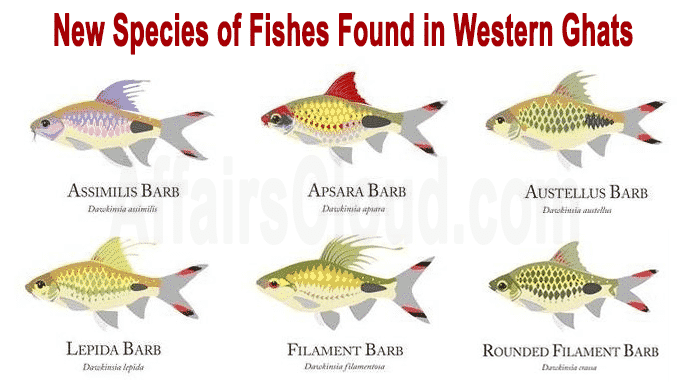 On May 9, 2020, Scientists from the Bombay Natural History Society (BNHS) based in Mumbai (Maharashtra), the Kerala University of Fisheries and Ocean Studies (KUFOS) and the Indian Institute of Science Education and Research (IISER), Pune (Maharashtra), have jointly discovered a three new fish species under the genus ‘Dawkinsia’ namely Dawkinsia apsara, Dawkinsia austellus, Dawkinsia crassa.
On May 9, 2020, Scientists from the Bombay Natural History Society (BNHS) based in Mumbai (Maharashtra), the Kerala University of Fisheries and Ocean Studies (KUFOS) and the Indian Institute of Science Education and Research (IISER), Pune (Maharashtra), have jointly discovered a three new fish species under the genus ‘Dawkinsia’ namely Dawkinsia apsara, Dawkinsia austellus, Dawkinsia crassa.
Key Points:
i.The species’ common names are filament barb, an active, lively, and peaceful fishes found in the rivers of peninsular India and Sri Lanka . They are marketable among aquarium hobbyists and are wild-collected and captive-bred for trade.
ii.About the 3 species:
- The 1st species ‘Dawkinsia apsara’, found in Karnataka’s Sita and Sowparnika rivers, has been christened after the beautiful celestial nymphs in Hindu mythology.
- The 2nd species ‘Dawkinsia austellus’, found from the Muvattupuzha river in Kerala, has been named referring to the Latin word for ‘South’ and refers to the distribution range of the species in Southern Kerala.
- The 3rd species ‘Dawkinsia crassa’, found in the Netravati river of Coastal Karnataka, has been named after the Latin word for ‘round/thick’ referring to the rounded appearance of the fish.
iii.This research on filament barb is a remarkable contribution to Indian Ichthyology ( branch of zoology devoted to the study of fish) and will help clear taxonomic confusions related to the small cyprinids of the genus Dawkinsia, to stabilise the specification of Dawkinsia assimilis & Dawkinsia lepida (the species of filament barbs described by British ichthyologists in the 1800s).
iv.The discovery has been published in the international journal Vertebrate Zoology, which is published from Senckenberg Museum in Germany & the lead author of the study was Unmesh Katwate, Fish Scientist, Freshwater Research Unit, BNHS, and Ph.D student at KUFOS.




